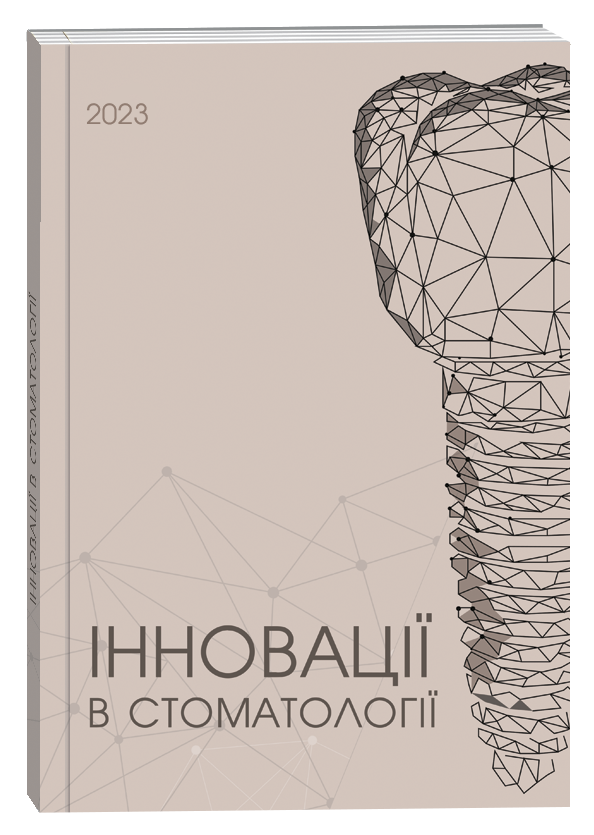ELECTROPHORETIC ACTIVITY OF BUCCAL EPITHELIAL CELLS IN CHILDREN WITH DENTAL DISEASES ON THE BACKGROUND OF INFECTIOUS MONONUCLEOSIS
DOI:
https://doi.org/10.35220/2523-420X/2023.3.6Keywords:
infectious mononucleosis, children, EFABEC, dental caries, periodontal diseaseAbstract
In recent years, there has been an increase in the incidence of infectious mononucleosis in children caused by the Epstein- Barr virus. Infection of the body with EBV viral infection is accompanied by immunosuppression, weakening of the protective mechanisms of the mucous membrane, which contributes to the activity of the pathogenicity of the bacterial microflora. High adhesion of microorganisms to epithelial surfaces in infectious mononucleosis patients serves as a basis for the development of pathological processes in the oral cavity. On the background of a decrease in local protection and general resistance of the body in infectious mononucleosis case, such conditions are created for the development of pathological processes in the periodontal tissues and a violation of the formation of enamel resistance. Functional disorders of oral cavity homeostasis and their relationship with dental status in children with infectious mononucleosis are insufficiently elucidated and require further research in order to implement effective approaches to their prevention. The purpose of the investigation is to evaluate EFABEC in children who fell ill with infectious mononucleosis in the presence of caries and chronic catarrhal gingivitis. Research methods. There were examined 37 children aged 7 and 12 years who were ill with infectious mononucleosis and 32 children of the comparison group were examined. The prevalence and intensity of caries, the condition of periodontal tissues and EFAKCE were evaluated in the examined children. Results of the research. It was found that the EFABEC in children who fell ill with infectious mononucleosis is, on average, 20.33±1.07%, which is significantly lower than that of children in the comparison group – 33.94±1.30%. In 7-year-old children of the main group, EFABEC is 1.71±0.33%, in 12-year-old children it increases by 2.5 times, respectively, in children of the comparison group it increases by 2.63 times (from 1.31±0.21% to 3.45±0.35%). The analysis of EFAKCE considering the dental status of children with infectious mononucleosis revealed that, on average, with DMF=2.99±0.29 teeth, EFABEC is 20.33±1.07%. In children with CPV=4.25±0.32 teeth in a complex with HCG, there is a pronounced decrease in the EFAKCE value, on average, to 9.64±0.52%. Such a tendency was found in both age groups of children who fell ill with infectious mononucleosis. In 7-year-old children with caries intensity of 2.54±0.29 teeth and HCG the index of EFABEC is lower by 48.25% relative to the indicator only in the presence of carious lesions, and in 12-yearold children, the EFABEC indicator is 2.21 times lower. Conclusions. EFABEC is reduced in children who have contracted infectious mononucleosis, which indicates a decrease in the protective mechanisms of the oral cavity. The study of EFABEC in children with an assessment of their significance serves to differentiate the use of means of prevention of dental diseases in children who have contracted infectious mononucleosis.
References
Методичні рекомендації по статистичній обробці. / Н. І. Смоляр та ін. Львів; 1995, 17.
Чухрай Н.Л. Вікові особливості електрофоретичної активності клітин букального епітелію при карієсі зубів у дітей різного шкільного віку. Вісник стоматології. 2013. № 1. С. 139-143.
Abdulnoor M., Khodai-Booran N., Pietrzyk et al. Epstein-Barr Virus Genetic Diversity in Blood vs. Saliva Samples from Patients with Infectious Mononucleosis. Open Forum Infetious Diseases. 2018. № 5(l). С 238 doi. org/10.1093/ofid/ofy210.664.
Amado F., Lobo M.J., Domingues P., Duarte J.A., Vitorino R. Salivary peptidomics. Expert Rev Proteomics. 2010. № 7(5). Р. 709-721. doi:10.1586/epr.10.48.
Andrei G., Trompet E., Snoeck R. Novel Therapeutics for Epstein⁻Barr Virus. Molecules (Basel, Switzerland). 2019. № 24(5). Р. 997. doi.org/10.3390/molecules24050997.
Asakawa M., Takeshita T., Furuta M. et al. Tongue Microbiota and Oral Health Status in Community-Dwelling Elderly Adults. mSphere. 2018. № 3(4) e00332-18 doi.org/10.1128/mSphere.00332-18.
Baker C. R., Kona S. Spontaneous splenic rupture in a patient with infectious mononucleosis. BMJ case reports. 2019. № 12(9). e230259 doi: 10.1136/bcr-2019-230259.
Batista T., Chaiben C. L., Penteado C. et al. Salivary proteome characterization of alcohol and tobacco dependents. Drug and alcohol dependence. 2019. № 204. Р. 107510 doi: 10.1016/j.drugalcdep.2019.06.013.
Bel'skaya L.V., Sarf E.A., Kosenok V.K., Gundyrev I.A. Biochemical Markers of Saliva in Lung Cancer: Diagnostic and Prognostic Perspectives. Diagnostics (Basel, Switzerland). 2020. № 10(4). 186. doi.org/ 10.3390/diagnostics10040186.
Bolis V., Karadedos C., Chiotis I. et al. Atypical manifestations of Epstein-Barr virus in children: a diagnostic challenge. Jornal de pediatria. 2016. № 92(2). Р. 113–121 doi.org/ 10.1016/ j.jped.2015.06.007.
Byrne A., Bush R., John, F., Upadhyay K. Limited Utility of Serology and Heterophile Test in the Early Diagnosis of Epstein-Barr Virus Mononucleosis in a Child after Renal Transplantation. Medicines (Basel, Switzerland). 2020. № 7(4). Р. 21 doi.org/10.3390/medicines7040021.
Ceraulo A. S., Bytomski J. R. Infectious Mononucleosis Management in Athletes. Clinics in sports medicine. 2019. № 38(4). Р. 555–561 doi.org/ 10.1016/j.csm.2019.06.002.
Dratva J., Caviezel S., Schaffner E., et al. Infectious diseases are associated with carotid intima media thickness in adolescence. Atherosclerosis. 2015. № 243(2). P. 609–615 doi.org/10.1016/j.atherosclerosis.2015.10.021.
Fourcade G., Germi R., Guerber F. et al. Evolution of ЕБВ seroprevalence and primary infection age in a French hospital and a city laboratory network, 2000-2016. PLoS ONE. 2017. № 12(4). Р. e0175574. doi.org/10.1371/journal.pone.0175574.
Iglesias-Velázquez Ó., López-Pintor R. M., González-Serrano J. et al. Salivary LDH in oral cancer and potentially malignant disorders: a systematic review and meta-analysis. Oral diseases. 2022. № 28(1). Р. 44-56 doi: 10.1111/odi.136302020.
Kamakura T., Hiraki A., Kikuchi M. Transient seizure-related MRI abnormalities in a child with primary Epstein-Barr virus infection. Pediatrics international. 2016. № 58(6). Р. 525–527 doi: 10.1111/ped.12844.
Klemola E. Cytomegalovirus as a possible cause of a disease resembling infectious mononucleosis. British Medical Journal. 1965. № 2(5470). Р. 1099–1102. 10.1136/bmj.2.5470.1099








